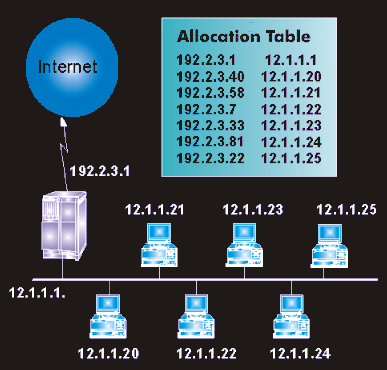network address translation (IP) (NAT)
The NAT (Network Address Translation) method is an address mapping method that translates IP addresses of one network into IP addresses of another network. The method is used to allow computers on a private network to share access to the Internet via the IP protocol. In the NAT procedure, the IP addresses of a private network are registered and mapped to publicly registered IP addresses.
The advantage of the NAT method is that all computers communicating with each other within a corporate network have access to the Internet via only one IPv4 address. This limits the number of public IPv4 addresses, which means less administrative work and more security.
Internal network addresses are special network addresses in an address range reserved for this purpose. They can only be used on the internal local network, are not publicly known, and are not routed through the NAT router located between the internal and public networks. Internal computers can use them to access internal network resources such as printers or servers. Only the computers that establish communication with external, public computers receive a table entry during routing in the NAT router. When data packets are transmitted, the source addresses of the internal computers in the NAT router are replaced by the public IPv4 address. The NAT router obtains this address from the NAT table. This procedure is also referred to as Source NAT( SNAT). If the transmission takes place from the Internet, it is a Destination NAT( DNAT).
The NAT procedure reduces the number of public IPv4 addresses and improves security because incoming or outgoing requests can bechecked by means of authentication. The network address translation can be used between company networks and the Internet, as well as between networks with IPv4 and IPv6 and vice versa. This enables the integration of an IPv4 infrastructure into IPv6 environments and allows IPv6 services to interact with IPv4 systems.
In addition to Network Address Translation (NAT), there are several other NAT variants such as Network Address Port Translation( NAPT), dynamic address mapping, Dynamic Network Address Translation (DNAT), and Static Network Address Translation (SNAT).

